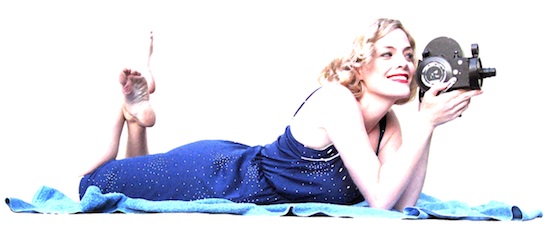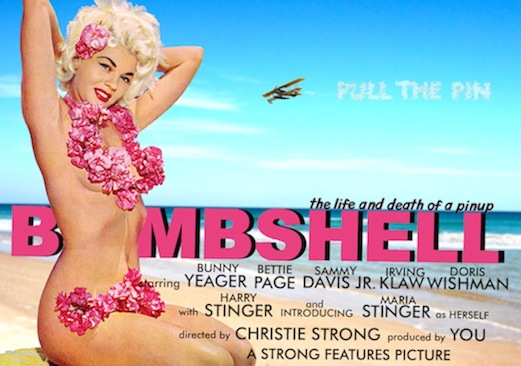The Internet has changed the way we tell our stories. It alters our memories and the ways we produce and perceive messages. It also opens up new channels for artists attempting to reach audiences, thus challenging and empowering independent storytellers to be more innovative when they seek cyber-support outside the studio systems and beyond the traditional gatekeepers. The storyteller now has the opportunity to engage with their audience -- to raise money, and/or provide insider access to a creative process as it unfolds, expanding the traditional narrative and (at times) allowing the funding process to become a part of the story.
This is the first in a series of articles and interviews that I'll be posting on innovative storytelling and crowdfunding. I'll explore the world of independent filmmakers, artists and storytellers using media in a creative way to tell their story and get their project funded. In this post, I'll take a closer look at the forward-thinking Kickstarter campaign for the movie, Bombshell: The Life and Death of a Pinup, a documentary film-in-the-making that uses crowdfunding and multimedia to expand the narrative of the story beyond the parameters of the film itself.
I'm interviewing filmmaker and director, Christie Strong of Strong Features about what it means to construct a transmedia story and how she's developing her own unique project using various social media sites to provide an interactive, immersive and ever-changing environment for her audience.
Like Strong, many artists are using experimental or heavily interactive methods, whether it's getting projects made using crowdfunding websites like Kickstarter, employing gaming techniques to tell their story (e.g. geotagging story elements in the serial fiction app, The Silent History), or participating in grassroots social media movements (like Felicia Day's web series, The Guild) that have the capacity to reach a "niche" audience of millions in a vast and limitless cyberspace.
High profile storytellers like Spike Lee, Zach Braff, James Franco and Rob Thomas for Veronica Mars are also turning to crowdfunding to raise funds and build communities that exist independently of the studio system. And if you want a convincing argument as to why, watch Amanda Palmer's incredibly important TED Talk that reframes the way we understand the relationships between artists and audiences, called "The Art of Asking."
I asked Ms. Strong why she chose to create a transmedia crowdfunding campaign and she told me that:
... crowdfunding is the future and every creator should give it a shot. There are so many ways to explore the world that you are creating. Instead of looking at the process of campaigning as a necessary evil, turn it into a vital phase not only for your film, but for your career as an independent creator. Realize that it is an opportunity to tell people who you are and the stories you care about. Invite them on the journey of discovery and creation with you. Trust them, confide in them, and collaborate with them. Think of the relationship not as a one-way street, but as one in which there is a sublime reciprocity, an exchange that flows two ways, bringing both parties out of their comfort zone and back to the center again. Almost like a dance.

Fascinated by Ms. Strong's perspective on crowdfunding as a part of the creative process, I asked her a few questions:
SS: Tell us about your project. Who are the main characters and what inspired you to make this film? What are the many layers of Bombshell?
CS: The bombshell of my film's title refers to my grandmother, Maria Stinger. She was known as "Miami's Marilyn" because of her resemblance to the star, and she was a pinup model who graced the covers of countless magazines in the 50s and early 60s. She was best friends with photographer Bunny Yeager, did bondage shoots with Bettie Page and starred in nudie films for directors like Doris Wishman. She was surrounded by these incredible, pioneering women, and yet she herself committed suicide when she was 34 years old. Why? It was such a mystery to me growing up, but at the same time, there was something I really connected to about her. She'd married at 17 and had my mother Spring a year later. I don't think she ever had a chance to really discover who she was or what she wanted to do. There was that '50s housewife mentality back then where society dictated that a woman's role was to serve her husband. If your identity is molded around another, what happens when you lose them? I've struggled with depression before, particularly after the loss of significant relationships. When I realized how contemporary her story was, and how familiar to my own experience, I realized that I could make a film about her. So the layers of Bombshell go very deep. The questions I'm posing are timeless. What do we inherit from our ancestors? Why do we lose ourselves to love? How do we keep going when there's nothing left? They're questions I am asking constantly in my own life, and I think other people are too.
SS: Why Kickstarter?
CS: Why Kickstarter is a loaded question! Inside of it is the question of why crowdfunding? The simplest answer is that I'm a first-time filmmaker. This puts me at a disadvantage with private investors and grants who rely on previous work to gauge my level of skill. I can write a compelling pitch for an incredible story with a knockout trailer, but without a track record of awards and completed films, I am at a serious disadvantage to those filmmakers who possess them. With crowdfunding you have this extraordinary opportunity to build awareness of yourself, your skills and your project. Still, I was hesitant to take it on until I had this 'aha' moment when I realized the campaign itself could be a creative endeavor instead of merely a financial means to one.
As for why Kickstarter, my choice of platform ultimately came down to exposure and design. The high profile campaigns that have recently graced Kickstarter have made it a recognizable, trustworthy platform for people who've never donated before. I also love Kickstarter's streamlined design. If you go to my campaign page you'll see I spent a lot of time on the aesthetics. I wanted the look to be as representative of the film as the video or the copy itself. Since the campaign page is essentially your digital press release, you really want it to knock people out.
SS: Your campaign is interactive and you describe it as a transmedia project. In what way? What is your definition of transmedia storytelling? Tell us a bit about how you're using various media and social media platforms to immerse your audience in this story.
CS: There are two things that were really important to me in my campaign: giving backers value immediately in return for their support, and having the campaign itself be a fulfilling creative process. If those two things couldn't happen then I didn't want to do the campaign. I've been interested in transmedia for a long time, which is defined as the telling of a single story across multiple platforms. It's such an exciting time to be a storyteller because every day there are new technologies being released, and the way that people are consuming stories is changing. If I was a successful, established storyteller, perhaps that would be frightening, but as someone just emerging I'm pretty giddy at the prospects. The idea that I could take a transmedia approach to the crowdfunding campaign itself really inspired me. I don't think it's ever been done before and that was exciting. What I didn't realize is how much creating the campaign would help me articulate the project at this stage. With documentaries you are really finding the story in post-production by selecting the bits of picture and sound that best tell it. In a way what I'm doing is pointing to the world contained in each little bit, each fragment of this larger story. Instead of being alone in the editing room, examining these story fragments, it becomes a process that the audience and I can do together.
SS: What are the story fragments?
CS: Fragments are, essentially, short bits of media that explore the film's story, themes and characters. Fragments may lead to other fragments, reference other fragments, or otherwise relate to each other in unique ways. Social media platforms are used in fairly straightforward ways. Facebook and Twitter are used as directionals. They point friends and followers to fragments. Twitter will tease content while Facebook provides more context as a hub for conversation and comments. Pinterest uses an organization system to arrange fragments thematically, videos live on my YouTube channel. Flickr hosts photos and Instagram is used for short video updates and personal pictures. Tumblr hosts blog posts and other writings and SoundCloud hosts audio podcasts. Live chats and interviews will take place on Google+ Hangouts on Air while the archive of these chats will be automatically posted to YouTube.
SS: For those of us interested in participating, where do we enter the story and what is the best way to engage with this project?
CS: If people want to experience the release of fragments in real-time, then they can follow me on all of the channels listed above, but for the most streamlined experience, I would point them to Facebook and Pinterest. Facebook updates you on [the release of] new fragments but there is also the opportunity for conversations and more engagement there, while Pinterest is enabling me to organize the fragments and pull them in from the other platforms. In the weeks ahead [Pinterest] is going to be revealed to play a larger part in the campaign as well. In a way, it's the backbone of the whole experience.

